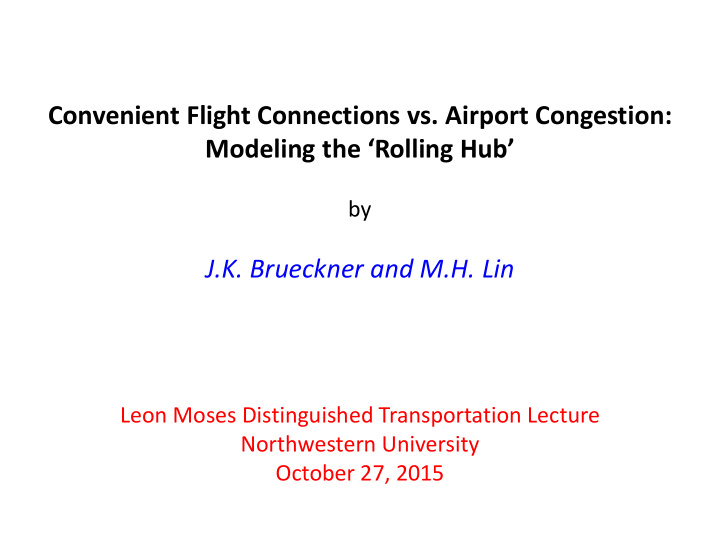



Convenient Flight Connections vs. Airport Congestion: Modeling the ‘Rolling Hub’ by J.K. Brueckner and M.H. Lin Leon Moses Distinguished Transportation Lecture Northwestern University October 27, 2015
INTRODUCTION In 2002, American Airlines depeaked its hubs, adopting a ‘rolling hub’ concept. Lowered congestion and operating costs, but lengthened layover times. Although Delta and United followed suit, the carriers are now abandoning the rolling hub, ‘rebanking’ their hubs.
Scott Kirby, American CEO said: “Although the continuous [rolling] hub lowered operating costs, the lost revenue outweighed the savings.” Marilyn DeVoe, vice president of AA’s Miami hub said: “Our hubs are all about connecting people, and rebanking allows us to do that more effectively.”
Lots of work has been done on the economics of hub-and- spoke networks. But the rolling-hub trade-off (convenient connections vs. airport congestion) has never been analyzed. Paper does so. It’s technical, but the ideas can be simply explained.
CONTINUOUS MODEL H-to-B A-to-H A-to-B
A-to-H shorter layover but more congestion H-to-B H-to-B Move flights closer together A-to-H
Airline incurs costs due to congestion. So do passengers, which reduces their willingness-to-pay and hence the fare the carrier can charge. For both reasons, profit falls as congestion increases. But passengers are willing to pay more for a shorter layover, offsetting this effect. Airline balances these two forces in spacing its flights.
DISCRETE MODEL Monopoly hub airline serves N endpoints over two periods (one flight to each) period 1 period 0 R endpoints served N - R endpoints served connecting passengers incur a LAYOVER cost if their endpoints are served in DIFFERENT PERIODS BUNCHING FLIGHTS IN ONE PERIOD ELIMINATES LAYOVERS BUT WORSENS CONGESION
MONOPOLY SOLUTION: If layover cost is high relative to congestion costs: period 0 period 1 0 endpoints served N endpoints served If layover cost is low relative to congestion costs: period 0 period 1 N/2 endpoints served N/2 endpoints served N/2 endpoints served
Add M fringe carriers to airport: HUB CARRIER period 0 period 1 N − R endpoints served R endpoints served FRINGE CARRIERS period 1 period 0 M − U endpoints served U endpoints served If hub carrier moves a flight from period 0 to 1 then a fringe flight moves from period 1 to 0 to equalize profit GOOD FOR HUB CARRIER since congestion unaffected but layovers fall
SOLUTION WITH FRINGE: HUB CARRIER period 0 period 1 N − X endpoints served X endpoints served FRINGE CARRIERS period 1 period 0 M endpoints served 0 endpoints served 0 ≤ X ≤ ( N − M )/2 (value depends on layover cost) So hub carrier serves at least ( N + M )/2 endpoints in period 1 ITS FLIGHTS ARE MORE CONCENTRATED THAN IN MONOPOLY CASE
SOLUTION WITH TWO HUB CARRIERS (NO FRINGE): If layover cost is high relative to congestion costs: period 1 period 0 Carrier A 0 endpoints served N A endpoints served Carrier B 0 endpoints served N B endpoints served If layover cost is low relative to congestion costs: period 0 period 1 Carrier A N A /2 endpoints served N A /2 endpoints served Carrier B N B /2 endpoints served N B /2 endpoints served
SOCIAL WELFARE? Are outcomes socially optimal, minimizing the sum of layover and congestion costs? Answer is YES in monopoly case (monopoly has no market power). But in any situation where different carriers both operate flights in the same period, outcome is inefficient. In fringe case, hub carrier’s flights are insufficiently concentrated (too many in period 0). In two-hub-carrier case, if carriers are present in the same period, more separation is better (but not necessarily complete separation).
The reason is a congestion externality. In moving a flight into a period, a carrier does not consider increase in congestion cost of other airlines operating there. But the carrier does consider the effect on congestion experienced by its own flights (internalization). Congestion tolls can remedy this problem.
CONCLUSION Analysis provides some insight into the rolling-hub trade-off. Most-realistic case combines hub carrier with fringe. Model says that the fringe carriers avoid the hub carrier’s period-1 bank, while the hub carrier may operate some flights outside the bank (in period 0). If so, that number is too large because of uninternalized congestion.
Does the model help explain the rise and fall of the rolling hub? Various mechanisms in the model could possibly account for this pattern, but none is compelling. Better explanation is pure experimentation: the airlines tried the rolling hub and eventually realized that it wasn’t beneficial.
Recommend
More recommend